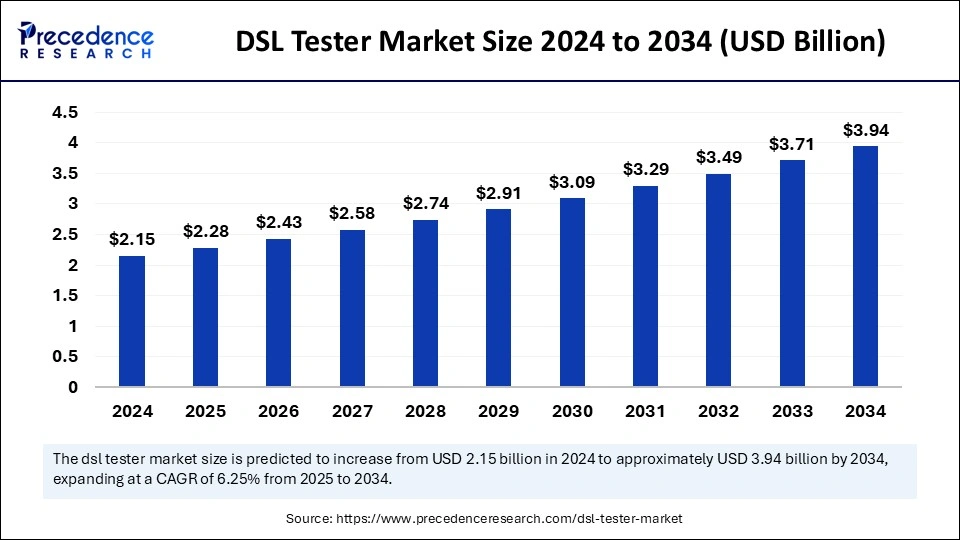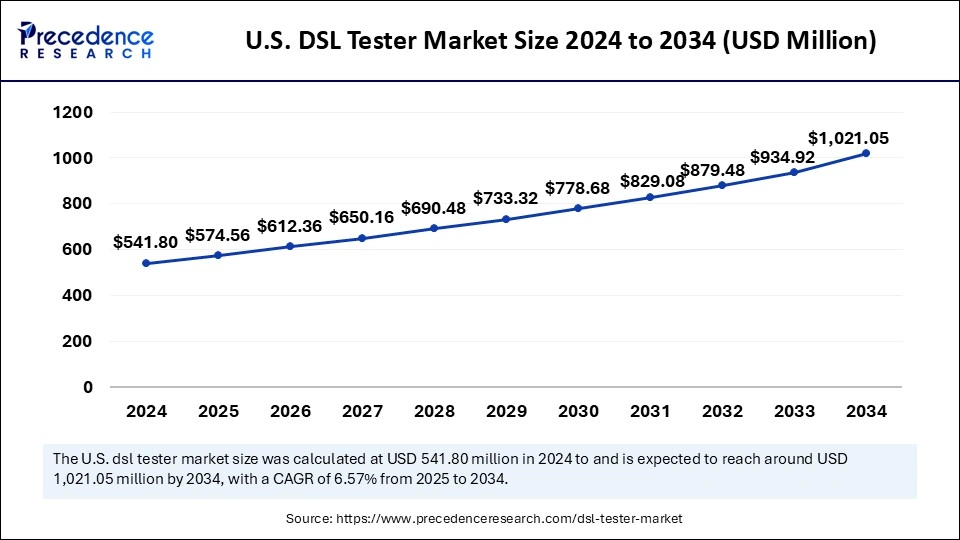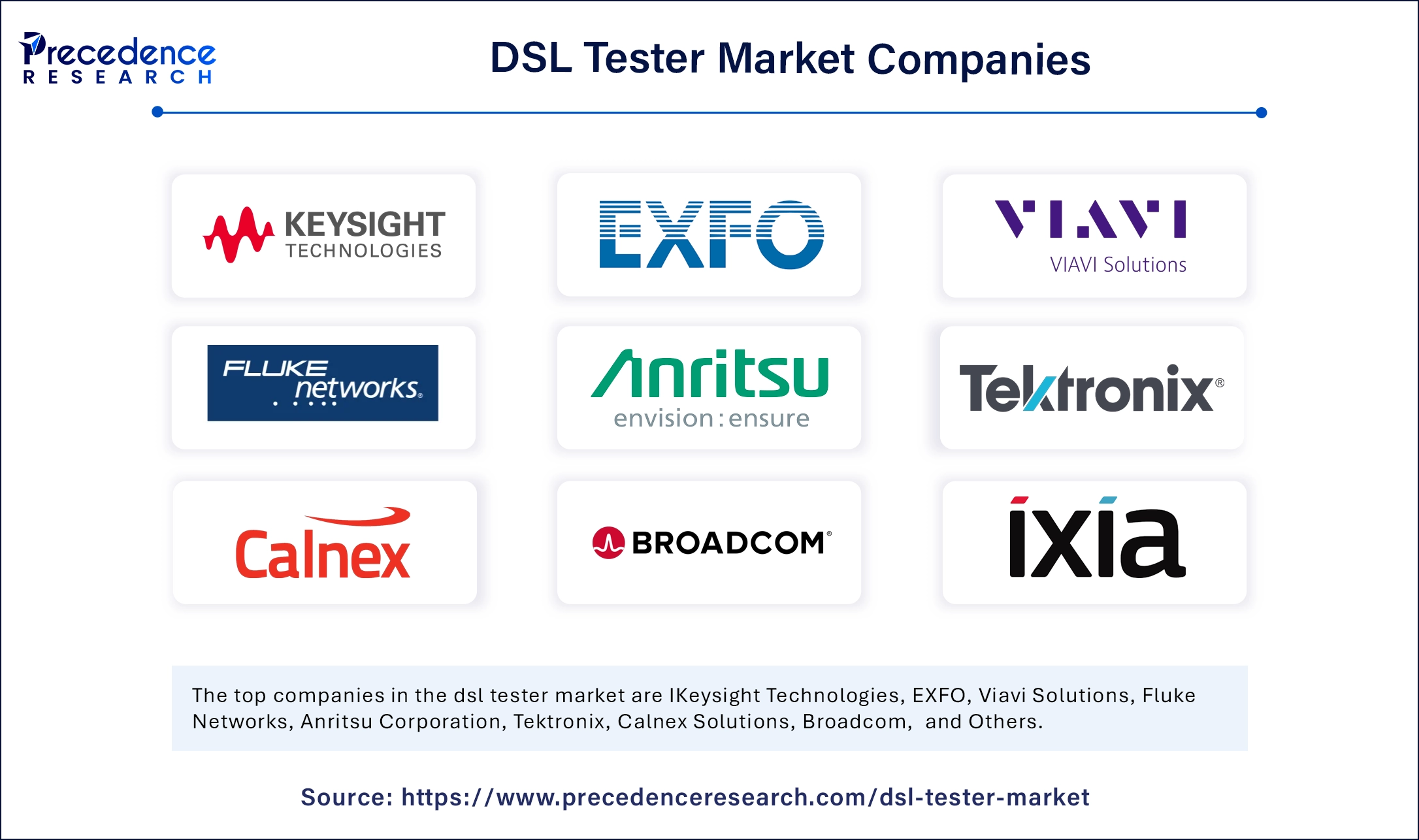The global DSL tester market size is evaluated at USD 2.28 billion in 2025 and is forecasted to hit around USD 3.94 billion by 2034, growing at a CAGR of 6.25% from 2025 to 2034. The North America market size was accounted at USD 774 million in 2024 and is expanding at a CAGR of 6.46% during the forecast period. The market sizing and forecasts are revenue-based (USD Million/Billion), with 2024 as the base year.
The global DSL tester market size was calculated at USD 2.15 billion in 2024 and is predicted to increase from USD 2.28 billion in 2025 to approximately USD 3.94 billion by 2034, expanding at a CAGR of 6.25% from 2025 to 2034. The growth of the market is driven by the increasing internet connections and the growing need to ensure network reliability.

The integration of Artificial intelligence algorithms in DSL testers predicts and prevents potential failures by analyzing vast amounts of data. These testers help automate the testing processes and address issues proactively, accelerating the testing process and improving the quality of DSL networks. AI-powered DSL testers monitor connections remotely, identify issues, and troubleshoot them automatically. This streamlines procedures and reduces manual work and errors.
The U.S. DSL tester market size was evaluated at USD 541.80 million in 2024 and is projected to be worth around USD 1,01.05 billion by 2034, growing at a CAGR of 6.57% from 2025 to 2034.

North America’s Dominance in the Market
North America dominated the DSL tester market in 2024. This is mainly due to its vast telecommunications infrastructure. There is a high demand for high-speed Internet in the region. DSL tester serves a broad range of requirements, from basic phone facilities in rural areas to high-speed Internet in urban centers. The increased usage of connected devices, IoT devices, and streaming services further bolstered the market growth in the region. In addition, the heightened usage of the Internet supported the region’s dominance. In 2024, around 90.0% of North Americans were internet users.
The U.S. is a major contributor to the North American DSL tester Market. In the U.S., mobile networks are progressively being used to provide broadband services for businesses and homes, driving the demand for DSL testers. Government programs like the Rural Digital Opportunity Fund are bridging the digital divide to support the deployment of broadband networks in rural areas. The strong presence of the high-tech workforce in the U.S. further supports market growth.

Asia Pacific: The Fastest-Growing Region
Asia Pacific is anticipated to witness the fastest growth during the forecast period. The regional market growth can be attributed to the rapid expansion of network infrastructure and increasing broadband access. Governments around the region are playing a significant role in driving digital transformation through incentives and ambitious policies. These initiatives not only encourage innovation but also create a favorable environment for citizens and businesses to thrive in the digital era.
China and India are expected to have a stronghold on the Asia Pacific DSL tester market. The presence of major telecom service providers in China, such as China Telecom, China Unicom, and China Mobile, drives the growth of the market. In addition, there is a high demand for high-speed internet in India. The Indian government is making efforts by launching various programs to improve access to the Internet, especially in rural areas. Increasing government programs related to digital networks, such as the Bharatnet project, further supports market growth.
Europe: A Notably Growing Region
Europe is observed to grow at a significant rate in the foreseeable future. This is mainly due to the increasing government support for electronic communication, such as the mission of BEREC to assist the Commission and national government authorities in the implementation of the EU telecoms rules. The rising mobile and internet usage in the region further contributes to market growth. In addition, the rapid expansion of the telecommunication sector is likely to support the growth of the market in Europe.
Digital subscriber line (DSL) is an internet access technology that uses a standard phone line to offer high-speed internet access. With DSL, a various frequency is used for digital and analog signals, which means that consumers talk on the phone while uploading data. DSL attracts an excessive deal of interest from service providers and integrators as it offers high-bandwidth data speeds to scattered sites with little changes to the current telecommunications infrastructure. The DSL tester market is growing rapidly due to the rising demand for high-speed internet. DSL testers are crucial for measuring the quality of DSL internet connections. They help identify potential issues in network, enhancing the quality and efficiency. DSL testers are crucial in activities such as streaming, large file downloads, online gaming, video conferencing, and VoIP phone calls.
| Report Coverage | Details |
| Market Size by 2034 | USD 3.94 Billion |
| Market Size in 2025 | USD 2.28 Billion |
| Market Size in 2024 | USD 2.15 Billion |
| Market Growth Rate from 2025 to 2034 | CAGR of 6.25% |
| Dominated Region | North America |
| Fastest Growing Market | Asia Pacific |
| Base Year | 2024 |
| Forecast Period | 2025 to 2034 |
| Segments Covered | Product Type, Technology, End Use, and Regions |
| Regions Covered | North America, Europe, Asia-Pacific, Latin America and Middle East & Africa |
Rising 5G Backhaul Demands
The rising demand for 5G backhaul is driving the growth of the DSL tester market. The fast deployment of 5G networks, characterized by dense small-cell infrastructure and heavy traffic loads, is increasing the demand for backhaul architecture to deliver high throughput, cost efficiency, scalability, and low latency. DSL lines are being increasingly leveraged to support the surge in data traffic across 5G backhaul networks, particularly in suburban and rural deployments where fiber may be economically unworkable. This shift is significantly driving the demand for DSL testers, which are essential for validating and maintaining DSL line performance under high data loads.
Transition to Fiber Optic Internet Creates Challenges
The rapid shift toward alternatives to DSL, like fiber optic and cable internet, creates challenges in the DSL tester market. As major telecom providers phase out DSL infrastructure in favor of high-bandwidth, low-latency solutions such as fiber, the relevance of DSL technology declines steadily, predominantly in well-connected and urban areas. Fiber optic networks have become ideal for modern digital communication due to their greater data capacity and negligible signal loss.
Adoption of DSL for High-Speed Connectivity
The extensive adoption of digital subscriber line (DSL) technology as an affordable solution for high-speed Internet access creates a significant opportunity for the DSL tester market. DSL allows simultaneous voice and data transmission over existing telephone infrastructure, eliminating the requirement for additional network investments and ensuring broad accessibility across rural and urban areas. This makes it a smart option for businesses and consumers seeking uninterrupted and reliable internet connection. DSL has become a foundational element in recent business internet facilities with benefits like faster download speeds, improved streaming capabilities, and improved connection stability compared to outdated dial-up services. This sustained reliance on DSL technology underscores the growing need for advanced DSL testers to ensure quality of service, support efficient installation, and maintain network performance.
The handheld DSL testers segment captured the largest share of the DSL tester market in 2024. The segment growth is driven by the increasing need for on-site network diagnostics. These testers generally feature a small LCD screen that displays the test outcomes and a keypad for monitoring the device, which makes them user-friendly. These testers are easy to use in the field, reducing test periods and enhancing reliability and accuracy for DSL line testing and troubleshooting.
The rack-mounted DSL testers segment is expected to grow at the fastest rate in the upcoming period. Rack-mounted testers take up minimal space in the work environment, making them the best choice for environments with limited space. These testers provide advantages like easy access for troubleshooting and maintenance, standardized testing, and the capability to test DSL modems and authenticate network connectivity.
The ADSL testers segment dominated the DSL tester market with the largest share in 2024. This is mainly due to the rise in the demand for high bandwidth. Asymmetric digital subscriber line (ADSL) testers enable quick transmission of data at a huge bandwidth on present copper wire telephone lines to businesses and home applications. ADSL instantaneously accommodates voice information and data on a similar phone line. It delivers traffic at various speeds, depending on direction, and supports a broad range of applications.
The VDSL testers segment is projected to expand at the fastest rate during the forecast period. Very high-speed digital subscriber line (VDSL) testers provide higher upload and download speeds. VDSL uses existing telephone lines; thus, extending the network facilities is often cost-effective and easier as compared to fiber optics.
The telecom operators segment dominated the DSL tester market in 2024. DSL testers enable simultaneous data and voice transmission, allowing telecom operators receive and make phone calls while using the internet. The signals of DSL and voice are separated in the different frequency channels, confirming that they do not interfere with each other. It has low installation expenses for network deployment, so DSL is a good option for telecom operators.
The service providers segment is anticipated to grow at a notable rate in the coming years. DSL testers enable service providers to maintain and upgrade huge networks. DSL tester is more beneficial than the cable as it provides stronger protection. Consumers will typically have a connection with various networks. DSL offers high-speed internet access that allows for faster browsing, streaming, and downloads. As compared to dial-up connections, DSL provides a more reliable and stable connection.

By Product Type
By Technology
By End-use
By Region
For inquiries regarding discounts, bulk purchases, or customization requests, please contact us at sales@precedenceresearch.com
No cookie-cutter, only authentic analysis – take the 1st step to become a Precedence Research client